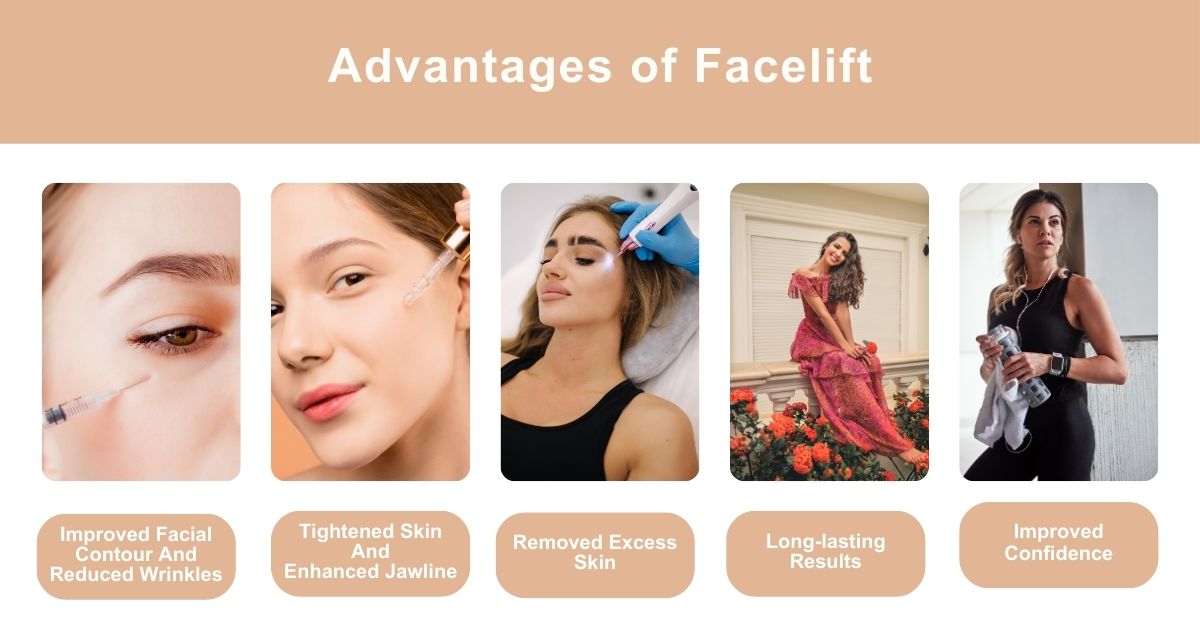With a facelift in Dubai, discover your eternal beauty! Witness a remarkable transformation as we reshape your natural contours under the direction of our skilled surgeon. Regain the pleasure of looking young, and exude confidence like never before.
What is a facelift?
A facelift, medically known as rhytidectomy, is a surgical procedure that aims to give a more youthful appearance to the face. It reduces sagging skin and wrinkles, primarily caused by ageing, sun damage, and lifestyle factors. The procedure typically involves tightening loose skin and removing excess, which results in a smoother and firmer facial profile.
Surgery on the cheeks, jaws, and neck is the primary focus of the facelift. However, it can be combined with other procedures like eyelid surgery or a brow lift for more comprehensive facial rejuvenation. Always remember that a facelift doesn’t stop the ageing process but resets the clock, giving you a refreshed and youthful look.
Types of facelift
Facelift procedures vary, tailored to the individual’s needs and the areas they wish to improve. The techniques have evolved, offering several variations focusing on different aspects of facial rejuvenation.
Deep Plane/SMAS Facelift
This procedure targets sagging skin at the base of the chin and neck by lifting and strengthening lax muscles. The surgeon repositions, reshapes, and smooths out the underlying musculoaponeurotic system (SMAS) layer to reduce wrinkles and provide a youthful appearance.
Mini Facelift
Using small incisions hidden under the hairline removes excess tissues, and the skin is tightened. This technique is particularly effective at reducing the appearance of jowls.
Mid-Facelift
Targeting the midsection of the face, especially the cheeks, this procedure lifts the cheeks, removes sagging, and reduces fine lines and wrinkles without using implants.
Cheek Lift
Like a mid-facelift, a cheek lift enhances cheekbones, reduces fine lines and wrinkles in the mid-face area, eliminates under-eye puffiness, and makes nasal folds less pronounced.
Jaw Line Rejuvenation
This procedure, which often includes neck liposuction, extracts excess fat cells from the neck area to contour and reshape the jawline for a smoother look.
S-Lift
During an S-Lift, an S-shaped incision is made on the lower half of the face, allowing the surgeon to separate the skin from underlying tissues, remove excess fat cells, lift the skin and contour underlying tissues for a smoother, wrinkle-free appearance.
Cutaneous Lift
Focusing on the lower face area, including the jaw and neck, this procedure involves incisions around the hairline and the ears, allowing the removal of excess skin and stretching the remaining skin for a wrinkle-free appearance.
Temporal or Brow Lift
This procedure, which involves a small incision along the hairline, lifts the skin and underlying muscles to reduce drooping skin on the eyelids.
Liquid Facelift
To stimulate collagen production and promote skin elasticity, injectable serums, such as Botox, Restylane, Dysport, or Juvederm, are injected into the face.
Advantages of Facelift
Facelift surgery offers many benefits, from cosmetic enhancements to boosting self-esteem and confidence. The rejuvenated appearance often has positive effects on a person’s mental well-being.

Improved Facial Contour
A facelift can redefine your facial structure, making your features more distinct and appealing. Adjusting the underlying structures of the face creates a more harmonious and balanced facial profile that enhances your natural beauty.
Reduction of Wrinkles
Facelifts smooth out wrinkles and reduce fine lines, making you look youthful and fresh.
This rejuvenation can take years off your face, making you appear more vibrant and full of life.
Tightened Skin
Facelifts combat sagging skin by tightening and lifting it, which results in a firmer and more youthful complexion. This procedure can significantly improve skin laxity, creating a more toned and revitalised look.
Enhanced Jawline
Facelifts can sculpt and enhance the jawline, providing a more defined and youthful profile. The procedure can reduce the appearance of jowls and other sagging skin, giving your jawline a more refined and chiselled look.
Removed Excess Skin
Facelifts involve removing excess skin that can dramatically improve sagging or loose skin appearance. This reduction of excess skin can result in a more streamlined and youthful facial structure.
Long-lasting Results
In contrast to some non-surgical procedures, the effects of a facelift can remain for several years. This long-lasting change provides a long-term remedy for the signs of ageing, with the outcomes improving as the early swelling and bruising decrease.
Improved Confidence
A facelift’s improved appearance frequently causes a significant increase in self-esteem and confidence. This improvement in your outward look can have a favourable impact on how you feel about yourself internally, resulting in enhanced social interactions and overall satisfaction.
The Procedure
A facelift involves several steps and techniques depending on the type of procedure performed. It is generally performed under general anaesthesia and involves making incisions, tightening facial muscles, removing excess skin, and redraping the skin.
Step 1 – Administering Anesthesia
For your comfort during the operation, specific medications are provided. These can be intravenous sedation or general anaesthesia; your doctor will advise the most suitable option. Enhancing the results of a facelift can be achieved with several additional procedures. These include:
Step 2 – Making the Incision
The nature of the incision is dictated by the facelift you opt for, which can be traditional, a limited incision facelift, or a neck lift.
Step 3 – Closing the Incisions
The incisions will be closed using sutures that may dissolve or need removal after several days. Some practitioners use skin glues to seal the incisions. Once healed, the facelift incision lines are effectively hidden within the hairline and natural contours of the face and ear.
Step 4 – Observing the Results
The noticeable enhancements of a facelift will appear after the swelling and bruising diminish. The outcome should provide a youthful, rested look and boost self-confidence. More information can be provided about the results of a facelift.
Before a Facelift
A facelift requires mental and physical preparation in the weeks and days leading up to the operation. This preparation often involves discussing your expectations with your surgeon, conducting pre-operative tests, and making lifestyle adjustments such as quitting smoking and avoiding certain medications. Additionally, you should arrange for someone to drive you home and stay with you the first night following surgery.
During a Facelift
The facelift procedure is typically performed under general anaesthesia or intravenous sedation. Your surgeon will make precise incisions depending on the type of facelift, remove or redistribute fat, tighten muscles, and redrape the skin. It generally takes a few hours, though the complexity of the operation can influence the time.
After a Facelift
Following the procedure, your face may be bandaged to avoid swelling and bruising, and a drain may be placed to prevent fluid buildup. Initial healing may include swelling, numbness, bruising, and tightness or tension in the face and neck. These are common and will subside with time.
Recovery
Performing the procedure and recovering from it are both equally important. It’s crucial to follow all post-op instructions provided by your surgeon, which may include caring for the surgical site, taking prescribed medications, and attending follow-up visits. Full recovery can take a few weeks, with most patients feeling comfortable in public within 10 to 14 days.
Healing Stages
| Stages | Description |
| Week 1 | Initial swelling and bruising, the face may feel tight |
| Week 2-3 | Most swelling and bruising subside, and stitches are removed |
| Month 1 | The sensation begins to ret; residual al swelling continues to diminish |
| Month 2+ | Final results become apparent; most residual swelling is gone |
Preoperative Care For facelift
Before a facelift procedure, the surgeon will provide detailed instructions to prepare you for the surgery. Following these guidelines will ensure the best results and recovery.
Postoperative Care For Facelifts
Recovery requires postoperative care. Following the surgeon’s instructions can help reduce potential complications and speed up recovery.
Who is a Suitable Candidate for a Facelift?
You should understand whether you’re a suitable candidate for a facelift before deciding whether to undergo it. Several factors influence your eligibility, including your overall health, skin elasticity, and personal expectations. Here are some characteristics of an ideal facelift candidate:
Who is Not a Suitable Candidate for a Facelift?
A facelift is a personal choice, but only some are good candidates. An individual’s health condition, lifestyle habits, and expectations can make them less suitable for this type of surgery.
Here are some reasons someone may not be an ideal candidate for a facelift:
What is the Ideal Age for Facelift?
Facelifts should not be performed at any age, as they can be primarily determined by genetics, skin type, lifestyle, and sun exposure. Most patients seeking facelifts are between 40 and 70 years old. Early signs of ageing, like decreased skin elasticity and the emergence of jowls and deeper wrinkles, are noticeable. There are many non-surgical treatments available, such as mini facelifts.
In contrast, those in their 50s and 60s experience more drastic changes in their faces, including wrinkles, significant sagging, and decreased volume.
It makes them suitable candidates for traditional or more comprehensive facelift procedures. Regardless of age, a candidate’s overall health, skin condition, and specific cosmetic objectives are crucial considerations. Hence, a personal consultation with a board-certified plastic surgeon is recommended to discuss individual needs and goals.
How Long Does the Procedure Take?
A facelift procedure takes a certain amount of time, depending on the type performed and the extent of the work. In general, the surgery takes about two to six hours.
How to Choose the Best Surgeon For Facelift in Dubai?
Choosing a skilled and experienced surgeon in Dubai is crucial to achieving optimal results. Consider their qualifications, experience, and patient reviews.
Why Choose Dr Shehzadi Tasneem Sultan?
Choosing Dr Shehzadi Tasneem Sultan for your facelift in Dubai means entrusting your care to a highly skilled and respected plastic surgeon known for her innovative techniques and dedication to patient-centric care.
Extensive Experience: Dr Sultan is a seasoned professional who started her career in Plastic Surgery at JBRS (Jinnah Burn and Reconstructive Surgery) in Lahore, Pakistan, and honed her skills at prestigious institutions like Great Ormond Street Hospital and St Thomas and Guys Hospital in London. She has also served in esteemed healthcare institutions in Dubai, including Rashid Hospital and SSMC (Shaikh Shakhboot Medical City).
Comprehensive Qualifications: Dr Sultan has an impressive academic background that includes Bachelor of Medicine and Bachelor of Surgery degrees from Allama Iqbal Medical College, a Fellowship in Plastic Surgery from the College of Physicians and Surgeons of Pakistan, and a BAPRAS from the British Association of Plastic Reconstructive and Aesthetic Surgeons, UK.
Member of Reputable Associations: Dr Sultan is a member of prestigious professional associations, including the Emirates Medical Association, the Emirates Plastic Surgeons Society (EPSS), and the Pakistan Association of Plastic Surgeons, signifying her commitment to high professional standards.
Innovative Techniques: Dr Sultan keeps herself updated with the latest techniques and advancements in plastic surgery, ensuring her patients benefit from advanced treatment options.
Personalised Care: Dr Sultan prioritises patient satisfaction and well-being and tailors each treatment plan to match her patient needs and desires.
Natural Results: Her refined surgical skills, artistic eye, and attention to detail ensure patients receive natural outcomes and enhance their overall appearance.
Free Consultation: Dr Sultan offers free consultations, allowing you to discuss your concerns and expectations for a facelift without obligation.
Trust your facelift to a specialist with a global reputation for excellence in facial rejuvenation. Book your free consultation today with Dr Shehzadi Tasneem Sultan and take the first step toward enhancing your natural beauty and regaining your confidence.














